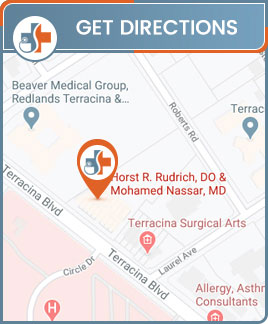Diabetes: What Is It, Causes, Symptoms, Treatment & Types
Diabetes affects people of all ages and is classified into numerous types. The signs and symptoms of diabetes include impaired vision, exhaustion, weight loss, and increased thirst or urination. If you or anyone around you is experiencing these symptoms, meet Dr. Mohamed Nassar M.D. For more information, contact us or schedule an appointment online. We are conveniently located at 255 Terracina Blvd, Suite 105 Redlands, CA 92373.


Table of Contents:
What are the first signs of being a diabetic?
How do you deal with diabetes?
What are the types of diabetes?
What are the treatments for diabetes?
Diabetes is a condition that affects how your body processes blood sugar or glucose. The first signs of diabetes can be subtle and may not cause noticeable symptoms for a while. However, some common early symptoms of diabetes include increased thirst and hunger, frequent urination, fatigue, blurred vision, slow-healing sores or bruises, and tingling or numbness in the hands or feet. These symptoms may not seem severe at first, but they can worsen over time and lead to serious complications if left untreated. Therefore, it’s important to see a doctor if you’re experiencing any of these symptoms, especially if you have a family history of diabetes or other risk factors.
Dealing with diabetes involves managing your blood sugar levels through a combination of lifestyle changes, medication, and regular monitoring. Some of the most effective ways to manage diabetes include:
• Eating a healthy diet: This includes choosing foods that are low in sugar and carbohydrates and high in fiber, protein, and healthy fats.
• Regular exercise: Physical activity can help lower blood sugar levels and improve overall health.
• Monitoring blood sugar levels: This involves checking your blood sugar regularly and adjusting your medication or insulin as needed.
• Taking medication: Insulin or oral medications can help regulate blood sugar levels.
• Managing stress: Stress can cause blood sugar levels to fluctuate, find ways to handle stressful situations by engaging in activities such as meditating or doing yoga.
It’s important to work with your doctor to develop a personalized treatment plan that’s designed for your individual needs and lifestyle. With proper management and care, many people who have diabetes are able to live healthy, active lives.
There are a few types of diabetes, but the common types are type 1 diabetes, type 2 diabetes, and gestational diabetes.
Type 1 diabetes: An autoimmune disorder in which the immune system fights the cells in the pancreas that produce insulin. This type of diabetes typically develops in adolescence or adolescence and requires lifelong insulin therapy.
Type 2 diabetes: A metabolic disorder in which the body becomes unaffected by insulin or can’t produce enough insulin to regulate blood sugar levels. This type of diabetes is often linked to lifestyle behaviors such as obesity and physical inactivity and can be managed through diet, exercise, medication, and/or insulin therapy.
Gestational diabetes: A diabetes that happens during pregnancy and typically resolves after delivery. This type of diabetes can increase the risk of complications during pregnancy and delivery could increase the development of type 2 diabetes later in life.
The treatment for diabetes depends on the type and severity of the condition. For type 1 diabetes, the number one treatment would be the medication insulin, which involves injecting insulin to regulate your blood sugar levels. People who have type 1 diabetes need to take insulin for the duration of their lives.
For type 2 diabetes, the initial treatment is typically lifestyle changes, such as losing weight, exercising regularly, and eating a healthy diet. If lifestyle changes aren’t enough to manage blood sugar levels, medications such as metformin or sulfonylureas may be prescribed. In some instances, insulin therapy may also be required.
Gestational diabetes is typically managed through behavior changes, such as changing your eating habits and starting or continuing to exercise, but medication or insulin therapy may be necessary in some cases.
In addition to medication and insulin therapy, people with diabetes should closely watch their blood sugar levels closely to ensure that they are within a healthy range. They should also work with their doctor to manage other risk factors for diabetes-related complications, such as high blood pressure and high cholesterol.
It’s important for people with diabetes to work closely with their doctors to develop a personalized treatment plan that’s tailored to their individual needs and goals. For more information, contact us or schedule an appointment online. We are conveniently located at 255 Terracina Blvd, Suite 105 Redlands, CA 92373. We serve patients from Redlands CA, Loma Linda CA, Mentone CA, Highland CA, Moonlight Rim CA, Grand Terrace CA, El Casco CA, Greenspot CA, and surrounding areas.

Additional Services You May Need
▸ Geriatric Medicine Doctors
▸ Diabetes Care
▸ Joint Injections For Arthritis Care
▸ Heart Disease
▸ Primary Care Physician
▸ Telemedicine
▸ Primary Care Doctor
▸ Internal Medicine Doctor





